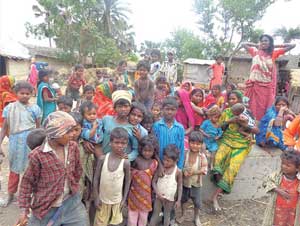Rautahat: The most child-illiterate district in Nepal

Rautahat: Despite the government’s decision to make education accessible to every child, there are 42,240 children in Rautahat who are still not within the reach of a school. Rautahat has the least literacy rate amongst all 75 districts in the country, and concerned authorities state that one third of the children in the district do not go to school.
According to Rural Development Center Rautahat, it is the children of the Dalit and the Muslim communities who are not in schools. Chairman of the Center, Paras Hussein, said that it is the lack of awareness in the parents and the poverty which act as barriers.
Children from the Dalit community don’t attend school even though a school is nearby. In Gaur municipality, children play on the school ground but do not study there. Similarly, in Pokhriya Tole and Sabgada Muslim Tole, most children don’t go to school.
None of the children from Purenawa Dhagar Tole in Gaur are literate. Almost two hundred children from the area don’t attend the nearby Bhagawati Primary School. Principal Nagendra Prasad Verma says, “Even though their names are enrolled in the school, they don’t come to the school unless they need to take their scholarship. Instead of attending classes, they are busy looking after their pigs and breaking stones.”
Newalal Dhangar, a local, has alleged that Dalit children refrain from going to school because they are made to sit on the floor in class while non-Dalit children sit on benches. However, Principal Verma has dismissed the claim and said that if lunch could be arranged for the students, then everyone would attend school. The Gaur Nagarpalika, which is also the district headquarters, has more than 1,000 children out of school, states Rural Development Center Nepal.
Rautahat has the largest Muslim community in the country, and Muslim leaders say there has been no development in the tendency of sending children to school. According to Maqsood Alam, member of Juddha Higher Secondary School’s management committee, the practices of involving children in household chores at young age and later sending them to Delhi, Mumbai and Kolkata in India in search of work is still prevalent. More than 50,000 youths in the district have left for various Indian cities and other countries looking for work.
Also the state of education of young female children of the Muslim community is very underdeveloped. Hussein says that there is a lot to be done about the education of girl children in the community.
There are 505 schools in the district, and yet many children don’t go to school. To correct this, the District Education Office has planned to bring all the children to school within this academic calendar. The plan has been made by all the resource persons and school supervisors. It will soon be implemented into a policy with the help of representatives from the media and non-government organizations, says Dilip Kumar Thakur, District Education Officer. He further said that there will be improvement in the literacy of the district.
Shiva Chandra Prasad Sah, Principal of Shankar Gudar Higher Secondary School in Samanpur, says because students are not taught in local languages, the literacy rate is the lowest in Rautahat. Sah believes it is easier for students to learn in their mother tongue, Bajjika.
According to District Education Officer Thakur, out of the eight districts where the state has decided to enroll 200,000 students, Rautahat is the most illiterate.
source:republica,12 may 2013
Posted on: 2013-05-12































